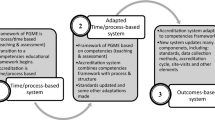Abstract
Background
Preparing a medical school for institutional review of all aspects of the school’s programs requires an understanding of the international standards being used and adequate preparation and planning (MacCarrick et al. in Med Teach 32(5):e227, 2010; MacCarrick in Ir J Med Sci, 2010). This series examines each of the nine standards developed by the World Federation for Medical Education (WFME) (World Federation for Medical Education in Basic medical education WFME global standards for quality improvement, WFME Office, University of Copenhagen, Denmark, 2003) with practical advice on their use in both self-review and independent accreditation processes.
Conclusion
The WFME standard 2 (Educational Program) examines in detail the program offered by the medical school, the instructional methods used to deliver the program, how the program is managed and how the program is linked with subsequent stages of the medical education continuum. Evidence of a strong nexus between the research activities of the medical school and the school’s teaching mission is vital. Accrediting teams will examine carefully the school’s resource allocation model and seek evidence of effective consultation by the school’s central curriculum committee.
Similar content being viewed by others
References
MacCarrick GR, Kelly C, Conroy R (2010) Preparing for an institutional self review using the WFME standards—an international medical school case study. Med Teach 32(5):e227–e232
MacCarrick GR (2010) A practical guide to using the World Federation for Medical Education (WFME) standards. WFME 1: mission and objectives. Ir J Med Sci (in press)
World Federation for Medical Education (2003) Basic medical education WFME global standards for quality improvement. WFME Office, University of Copenhagen, Denmark. Available at: http://www.wfme.org. Accessed 1 Sept 2010
Li ST, Paterniti DA, Co JP, West DC (2010) Successful self-directed lifelong learning in medicine: a conceptual model derived from qualitative analysis of a national survey of pediatric residents. Acad Med 85(7):1229–1236
Bruner JS (1960) The process of education. Vintage Books, New York
Masters K, Gibbs T (2007) The spiral curriculum: implications for online learning. BMC Med Educ 7:52
Harden RM (1999) What is a spiral curriculum? Med Teach 21(2):141–143
Bloom B, Englehart M, Furst E, Hill W, Krathwohl D (1956) Taxonomy of educational objectives: the classification of educational goals. Handbook I: Cognitive domain. Longmans Green, New York
Kennedy D (2007) Writing and using learning outcomes: a practical guide. University College Cork, Cork
Biggs J (2003) Teaching for quality learning at university, 3rd edn. Open University Press, Buckingham
Author information
Authors and Affiliations
Corresponding author
Rights and permissions
About this article
Cite this article
MacCarrick, G. A practical guide to using the World Federation for Medical Education standards. WFME 2: educational program. Ir J Med Sci 179, 489–491 (2010). https://doi.org/10.1007/s11845-010-0574-3
Received:
Accepted:
Published:
Issue Date:
DOI: https://doi.org/10.1007/s11845-010-0574-3




